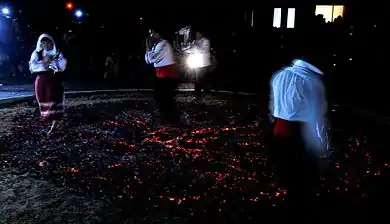Verbunkos
Verbunkos (Hungarian: [ˈvɛrbuŋkoʃ]), other spellings being Verbounko, Verbunko, Verbunkas, Werbunkos, Werbunkosch, Verbunkoche; sometimes known simply as the hongroise or ungarischer Tanz (Bellman 2001) is an 18th-century Hungarian dance and music genre.
| Music of Hungary | |
|---|---|
| General topics | |
| Portal | |
| Genres | |
| Media and performance | |
| Music awards |
|
| Music charts | Mahasz |
| Music festivals | |
| Music media | Print media
Music television |
| Nationalistic and patriotic songs | |
| National anthem | "Himnusz" |
| Other | Szózat Székely Himnusz Nemzeti Dal |
The verbunkos is typically in a pair of sections, slow (lassú), with a characteristic dotted rhythm, and fast (friss), with virtuosic running-note passages. In some cases, this slow-fast pair alternates at greater length (Bellman 2001).
The name is derived from the German word Werbung, a noun derived from the verb werben that means, in particular, "to recruit"; verbunkos—recruiter. This music and dance was played during military recruiting before the Habsburg Emperors, who were also Kings of Hungary, introduced conscription in 1849. A group of a dozen hussars performed the dance in different parts, with the leading sergeant opening with slow movements, then the lower officers joining for more energetic parts, and the youngest soldiers concluding the dance with jumps and spur-clicking (Bellman 2001).
Despite its name, the melodies originate from Hungarian folk and popular music and have been sometimes attributed to Romani people (Gypsies), because the accompaniment was usually played by Romani musicians in characteristic Romani style (Bellman 2001; Head 2005, 89; Loya 2011, 17).
The Romani composer János Bihari (1764–1827) remains the most well-known composer and interpreter of verbunkos. Eighty-four compositions of his remain (Sisa 1990, 301). Bihari was an accomplished violinist during his lifetime, and he played in the court in Vienna during the entire Congress of Vienna in 1814. Another composer of verbunkos was József Kossovits (d. c. 1819).
Already with the establishment in 1837 of the Hungarian National Theatre in Pest, the verbunkos style had begun to change under the influence of the first director of the theatre and Hungary's most important operatic composer, Ferenc Erkel, whose most successful operas were Hunyadi László (1844) and Bánk bán (1861) (Sisa 1990, 301).
Haydn incorporated verbunkos into the well-known "Gypsy Rondo" piano trio, composed in 1795. Béla Bartók's Contrasts (1938), a trio for clarinet, piano and violin, is in three movements, the first of which is named Verbunkos. His Violin Concerto No. 2 is also an example of verbunkos style.
Slovácko verbuňk
The Slovácko verbuňk is also an improvised folk dance in the South Moravia and Zlín districts of the Czech Republic, and was inscribed in 2008 on the Representative List of the Intangible Cultural Heritage of Humanity of UNESCO (Anon. n.d.).
See also
Sources
- Anon. n.d. "Slovácko Verbuňk, Recruit Dances". UNESCO website (Accessed 8 April 2012).
- Bellman, Jonathan. 2001. "Verbunkos". The New Grove Dictionary of Music and Musicians, second edition, edited by Stanley Sadie and John Tyrrell. London: Macmillan Publishers.
- Head, Matthew. 2005. "Haydn's Exoticisms: 'Difference' and the Enlightenment". In The Cambridge Companion to Haydn, edited by Caryl Leslie Clark, 77–94. Cambridge Companions to Music. Cambridge and New York: Cambridge University Press. ISBN 9780521833479 (cloth) ISBN 9780521541077 (pbk).
- Loya, Shay. 2011. Liszt's Transcultural Modernism and the Hungarian-Gypsy Tradition. Eastman Studies in Music 87. Rochester: University Rochester Press. ISBN 9781580463232.
- Sisa, Stephen. 1990. The Spirit of Hungary: A Panorama of Hungarian History and Culture, second edition. A Wintario Project. Morristown, N.J.: Vista Books. ISBN 0962842206. Chapter 41 "Hungarian Music" (pp. 299–306) at Corvinus Library – Hungarian History (Accessed 17 September 2012).
